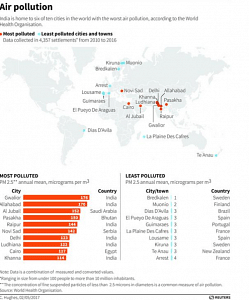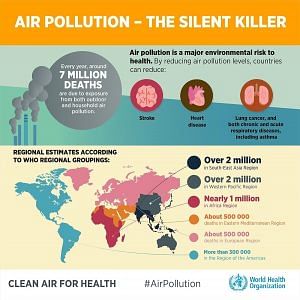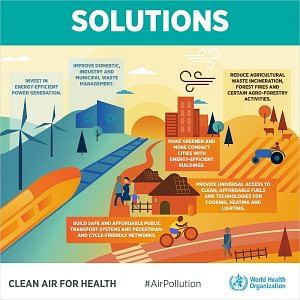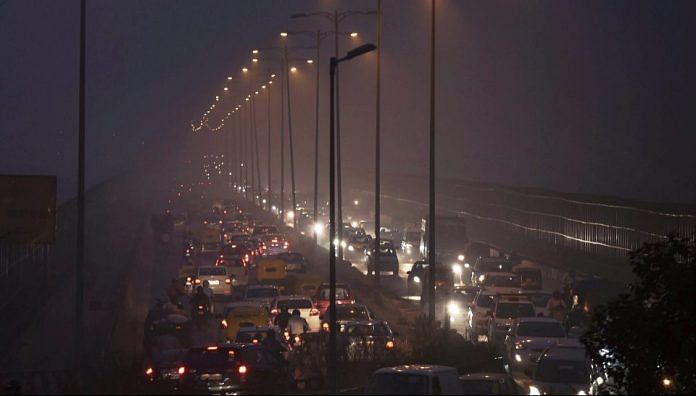WHO study shows that of the estimated 7 million deaths per year from air pollution, more than 90% happen in low- and middle-income countries, mainly in Asia and Africa.
Nine out of 10 people worldwide breathe polluted air, but it is the poor who are disproportionately affected, according to a new study.
Figures from the World Health Organization show that air pollution levels remain “dangerously high” in many parts of the world.
Up to 7 million people – the vast majority in developing countries – die prematurely every year because of air pollution, according to the WHO findings.
Though some rich nations have succeeded in improving air quality, the situation is getting worse in poorer countries.
Air pollution around the world

In general, air pollution levels are lowest in high-income countries, particularly in Europe, the Americas and the Western Pacific.
The WHO says the worst outdoor air pollution is to be found in cities in the eastern Mediterranean and Southeast Asia regions, where levels are more than five times above the WHO’s recommended limits, followed by low- and middle-income cities in Africa and the Western Pacific.
According to the latest air quality database, 97% of cities with more than 100,000 inhabitants in low- and middle-income countries do not meet WHO air quality guidelines. However, in high-income countries, that figure decreases to 49%.
Of the world’s 20 most polluted cities, 15 are in India.
Viraj Mehta, Head of Regional Agenda, India and South Asia at the World Economic Forum, says that while India has pledged to take action, the reality on the ground is that there is a large amount of work to be done to tackle the air pollution crisis.
“Air pollution has huge implications on public health cost, labour productivity and economic development. Prime Minister Modi in his 2018 Davos speech termed climate change one of the critical challenges facing civilization.
“However, a lot still needs to be done to match India’s global ambitions with domestic realities where related problems like air pollution are as acute in the rural areas as in urban. There is urgent need for policy-makers and businesses to come together for setting up and adhering to transition towards sustainable growth,” he says.
Death by pollution

The fine particles in polluted air penetrate deep into the lungs and cardiovascular system, resulting in a variety of diseases including stroke, heart disease and lung cancer.
Of the estimated 7 million deaths that occur every year from exposure to these particles, 4.2 million are caused by outdoor air pollution, and 3.8 million by cooking with polluting fuels such as kerosene, biomass (wood, animal dung and crop waste) and coal.
But more than 90% of those deaths happen in low- and middle-income countries, mainly in Asia and Africa, followed by low- and middle-income countries of the eastern Mediterranean region, Europe and the Americas.
What’s the solution?

Air pollution comes from many sources, including transportation, power plants, oil refineries, industrial facilities, factories and the burning of waste.
Among the obvious solutions are making transport systems more sustainable, including encouraging people to walk and cycle more, investing in energy-efficient power production and changing the way we manage waste.
One of the key measures to tackle indoor pollution is to give everyone access to clean fuels and cooking facilities.
The WHO highlights a scheme in India, which gave free LPG connections to 37 million women living below the poverty line. The Pradhan Mantri Ujjwala Yojana Scheme aims to protect women and children from smoke emitted in the home when cooking with firewood.
Countries need to work together on solutions for sustainable transport, more efficient and renewable energy production and use and waste management, says the WHO.
“Political leaders at all levels of government, including city mayors, are now starting to pay attention and take action,” says Dr Tedros Adhanom Ghebreyesus, Director-General of the WHO.
“The good news is that we are seeing more and more governments increasing commitments to monitor and reduce air pollution as well as more global action from the health sector and other sectors like transport, housing and energy.
By arrangement with World Economic Forum



